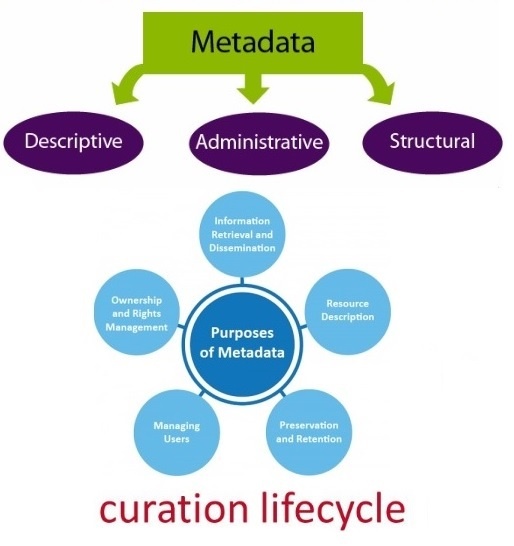Assigning METADATA as method to support DIGITAL DATA CURATION in trusted repositories
14/09/2017


(Image sources: ©Open Source Guide to ESI; ©The University of Queensland ; © Boston College Libraries; ©SlidePlayer: Research Data Management Overview and Introduction)
|
GOOD METADATA is key for data access and re-use. Nevertheless ... these specifications and standards are only effective or F.A.I.R. (aiming to increase Findability, Accessibility, Interoperability of the data) if people know about them, and use them in a coordinated manner... |
This essay provides overview about Digital Data Curation, metadata on its support, and links for futher reading.
.png) Digital Data Curation Lifecycle & Metadata on its support
Digital Data Curation Lifecycle & Metadata on its support
Digital Data Curation involves maintaining, preserving and adding value to digital data/digital object throughout its lifecycle.
|
Digital Objects: simple digital objects (discrete digital items such as text files, image files or sound files, along with their related identifiers and metadata) or complex digital objects (discrete digital objects made by combining a number of other digital objects, such as websites), - see DCC Glossary. |
The DCC Curation Lifecycle Model ![]() Download the Curation Lifecycle Model
Download the Curation Lifecycle Model ![]()
provides a graphical, high-level overview of the stages required for successful curation and preservation of data/digital object from initial conceptualisation, capture or receipt through the iterative curation cycle.
This ideal lifecycle model - - as is thought out at the start of a data management project and planned for throughout - - presents granular functionality of three sets of actions and can be used to plan activities within your organisation, to ensure that all of the necessary steps in the curation lifecycle are covered.
|
|
Description &Representation Information |
|
|
Preservation Planning |
|
|
Community Watch & Participation |
|
|
Curate & Preserve |
|
|
Conceptualise |
|
|
Create or Receive: Create data including administrative, descriptive, structural and technical metadata. Preservation metadata may also be added at the time of creation. Receive data, in accordance with documented collecting policies, from data creators, other archives, repositories or data centres, and if required - assign appropriate metadata. |
|
|
Appraise & Select |
|
|
Preservation Action: Preservation actions should ensure that data remains authentic, reliable and usable while maintaining its integrity. Actions include data cleaning, validation, assigning preservation metadata, assigning representation information and ensuring acceptable data structures or file formats. |
|
|
Store |
|
|
Access, Use & Reuse |
|
|
Transform |
|
|
Dispose |
Depending on method for Data Management & Curation that is being chosen/followed
- - according to the policies and procedures that underpin curation within an organisation - -,
one can map <roles and responsibilities> in delivering curation, and the <framework of standards and technologies> that support it at any point of the Curation Lifecycle Model.
This approach can be helpful in identifying gaps in digital curation planning, in undertaking mitigation actions, and in documenting adequately all workflows and resources required to support specific digital curation processes. In other words, users may enter at any stage of the digital curation lifecycle depending on their current area(s) of need, when, e.g.:
- Considering curation from the point of ingest,
- Refining the support offered during the conceptualisation and creation processes,
- Improving data management in all its stages, including long-term preservation.
|
Some good practices in research data management:
(1) Open Archival Information System (OAIS) Reference Model (2012) compliance |
The active digital data curation (in TDR) reduces threats to long-term data value (including data quality) and mitigates the risk of digital obsolescence:
|
|
Metadata plays an important role in the discovery of information found in digital databases and repositories, library catalogs. Metadata is providing access to the wide variety of resources made available through archival finding aids. Thus, metadata is considered to be the backbone of Digital Curation.
Usually taking the form of a structured set of descriptive elements, metadata assists in the identification, location, processing, tracking, preserving, sharing / re-use and retrieval of data/information resource, while facilitating content and access management.
Without metadata - a digital resource may be irretrievable, unidentifiable or unusable.
.png) Towards alignment of different metadata structures
Towards alignment of different metadata structures
Although the common goal of (descriptive - structural - administrative) metadata is that to help you to work (both at technical and not technical level) with your data/digital objects, your metadata structures may not match the structures used by others.
That can make it harder to communicate your data, making it less findable, accessible, interoperable and reusable (FAIR). To avoid these problems, many communities have established metadata standards or community specifications/recommendations, for the minimum information that should be collected about data/digital object in order for it to be re-used. You may take a look at:
|
Some examples of metadata standards promoted/endorsed by different communities:
|
... but these are only effective if people know about them and use them. To cope with this challenge, for instance:
|
In a first phase of work, the RDA Metadata Standards Directory Working Group (MSDWG) took the aforementioned DCC Disciplinary Metadata Catalogue as its base and updated and extended the information contained within it. |
|
the metadata normalization/alignment could be accomplished. |
Related:
- See DCC Curation Lifecycle Model FAQ for more information.
- Also, DCC Digital Curation 101 and 101 Lite courses introduce researchers and data custodians to the stages of the Curation Lifecycle Model.
- Digital Preservation Handbook: a strategic overview of the broad issues & tasks involved in preserving digital resources
- NISO Recommended Practice on Metadata Indicators for Accessibility and Licensing of E-Content
